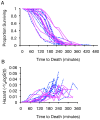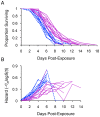Natural variation for lifespan and stress response in the nematode Caenorhabditis remanei
- PMID: 23658604
- PMCID: PMC3637273
- DOI: 10.1371/journal.pone.0058212
Natural variation for lifespan and stress response in the nematode Caenorhabditis remanei
Abstract
Genetic approaches (e.g. mutation, RNA interference) in model organisms, particularly the nematode Caenorhabditis elegans, have yielded a wealth of information on cellular processes that can influence lifespan. Although longevity mutants discovered in the lab are instructive of cellular physiology, lab studies might miss important genes that influence health and longevity in the wild. C. elegans has relatively low natural genetic variation and high levels of linkage disequilibrium, and thus is not optimal for studying natural variation in longevity. In contrast, its close relative C. remanei possesses very high levels of molecular genetic variation and low levels of linkage disequilibrium. To determine whether C. remanei may be a good model system for the study of natural genetic variation in aging, we evaluated levels of quantitative genetic variation for longevity and resistance to oxidative, heat and UV stress. Heritability (and the coefficient of additive genetic variation) was high for oxidative and heat stress resistance, low (but significant) for longevity, and essentially zero for UV stress response. Our results suggest that C. remanei may be a powerful system for studying natural genetic variation for longevity and oxidative and heat stress response, as well as an informative model for the study of functional relationships between longevity and stress response.
Conflict of interest statement
Figures




References
Publication types
MeSH terms
Substances
Grants and funding
LinkOut - more resources
Full Text Sources
Other Literature Sources
Miscellaneous

